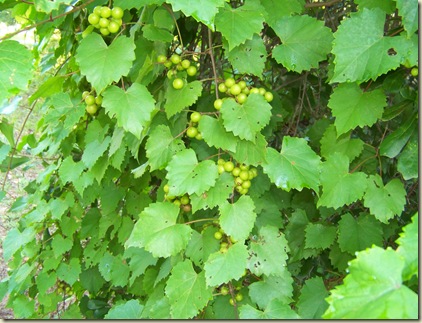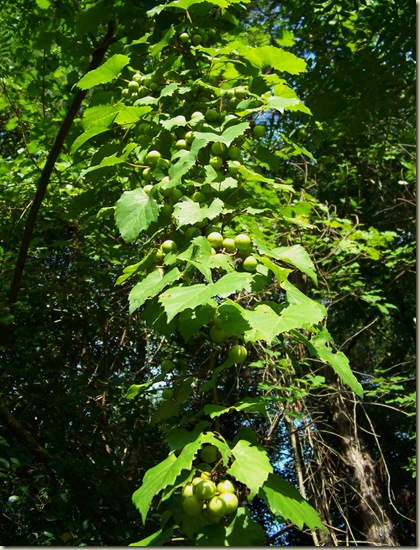It's early and they are green.
But the promise is there. At the end of summer, the green will be purple black and the mature grapes will beckon us to taste their sweetness. It is helpful to remember from which vines we will taste, and which ones we will merely admire. In our neighborhood, we have two kinds of native grape vines: muscadines and fox grapes. Only the muscadines (Vitus rotundifolia) are eaten. Vitus is a Latin word, meaning "life". There is an assortment of common names given to muscadines which include Bullace and scuppernongs. All scuppernongs are muscadines. But not all muscadines are scuppernongs. Scuppernongs take their name from the river in North Carolina where the bronze muscadines were first found by early settlers. Fox grapes and muscadines look very similar. The muscadines are larger and have a sandier surface on the skin than the fox grapes. Both of these species have been used as cultivars for many other varieties.
These are fox grapes. The picture above is a muscadine vine.
 Grape growing is an ancient agriculture. Most homesteads had grapevines whose fruits were eaten fresh and preserved as jams, jellies and wine. Our local Mission San Luis has a great example of an old arbor. Agricultural colleges in this country have been researching and developing new varieties since before the early 1800's to improve the characteristics of the native grapes. These characteristics include grape size, flavor, sweetness, acidity, shelf life, skin, color and seedlessness. The Concord grape that is grown up north will not grow here because of climate-related diseases. A result of the research is dozens of varieties of named grapes that all had their beginnings in native grapes.
Grape growing is an ancient agriculture. Most homesteads had grapevines whose fruits were eaten fresh and preserved as jams, jellies and wine. Our local Mission San Luis has a great example of an old arbor. Agricultural colleges in this country have been researching and developing new varieties since before the early 1800's to improve the characteristics of the native grapes. These characteristics include grape size, flavor, sweetness, acidity, shelf life, skin, color and seedlessness. The Concord grape that is grown up north will not grow here because of climate-related diseases. A result of the research is dozens of varieties of named grapes that all had their beginnings in native grapes.
When we were house hunting, we once looked at a house in south Georgia that had an extensive vineyard. Every row had the variety name posted, indicating that many varieties were growing there. I have to wonder if we had that much wine-making potential, if we would ever get anything done afterwards!
So we take our walks, and we watch and we wait. And one day, we will come home with a few in our pocket and a sweet taste in our mouth.

3 comments:
What a great post!
Ah, yes! The first time I tasted scuppernongs was years ago in Bristol, in a small grocery store. I bit into the first one, chewed it, took out the pit, and swallowed. The cashier looked at me as though I was from another planet, and said, "Around here we generally spit out the hull." Hull, meaning the skin.
I'm sure you know this, but FAMU has long had a viticulture (and small fruit) program. Their vineyard is out Mahan, where (I think) the old LaFayette winery was.
Googling 'FAMU viticulture' gets, among others, these two .pdf files: FAMU Grape Harvest 2007, FAMU Viticulture 2006 Wine Festival.
We truly enjoy your blog!
We thank you for you regular comments. As a matter of fact several years ago, B attended a viticulture symposium held on the FAMU campus.
Post a Comment